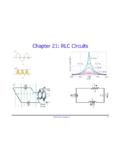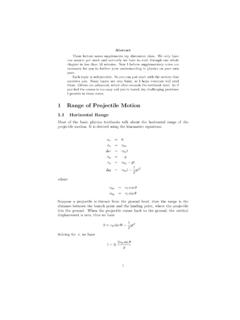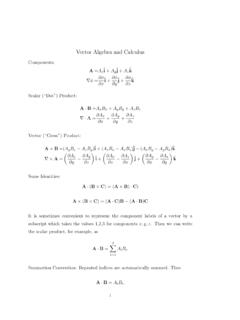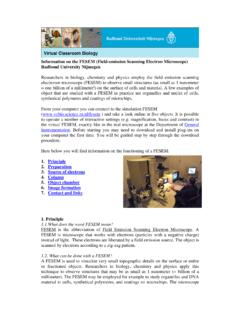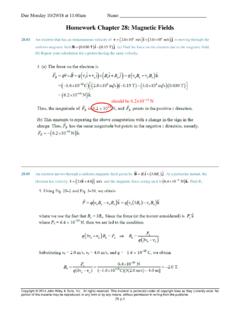Transcription of Magnetic Dipoles Magnetic Field of Current Loop
1 PHY2061 Enriched Physics 2 Lecture Notes Magnetic Dipoles D. Acosta Page 1 10/24/2006 Magnetic Dipoles Disclaimer: These lecture notes are not meant to replace the course textbook. The content may be incomplete. Some topics may be unclear. These notes are only meant to be a study aid and a supplement to your own notes. Please report any inaccuracies to the professor. Magnetic Field of Current Loop For distances Rr (the loop radius), the calculation of the Magnetic Field does not depend on the shape of the Current loop. It only depends on the Current and the area (as well as R and ): 0303cos24 where is the Magnetic dipole moment of the loopsin4rBRiBR = == = B A Here i is the Current in the loop, A is the loop area, R is the radial distance from the center of the loop, and is the polar angle from the Z-axis.
2 The Field is equivalent to that from a tiny bar magnet (a Magnetic dipole). We define the Magnetic dipole moment to be a vector pointing out of the plane of the Current loop and with a magnitude equal to the product of the Current and loop area: The area vector, and thus the direction of the Magnetic dipole moment, is given by a right-hand rule using the direction of the iA KK y x R I B r iPHY2061 Enriched Physics 2 Lecture Notes Magnetic Dipoles D. Acosta Page 2 10/24/2006 Interaction of Magnetic Dipoles in External Fields Torque By the exti= FLB force law, we know that a Current loop (and thus a Magnetic dipole) feels a torque when placed in an external Magnetic Field : ext= B The direction of the torque is to line up the dipole moment with the Magnetic Field : Potential Energy Since the Magnetic dipole wants to line up with the Magnetic Field , it must have higher potential energy when it is aligned opposite to the Magnetic Field direction and lower potential energy when it is aligned with the Field .
3 To see this, let us calculate the work done by the Magnetic Field when aligning the dipole. Let be the angle between the Magnetic dipole direction and the external Field direction. sin sin (where )WddsrddsrddWd = == = = = FsFFrF Now the potential energy of the dipole is the negative of the work done by the Field : UW d = = The zero-point of the potential energy is arbitrary, so let s take it to be zero when =90 . Then: /2/2sinUd Bd =+=+ Bext i FF PHY2061 Enriched Physics 2 Lecture Notes Magnetic Dipoles D. Acosta Page 3 10/24/2006 The positive sign arises because dd = , and are oppositely aligned. Thus, /2cos cosUBB = = Or simply: U= B The lowest energy configuration is for and B parallel.
4 Work (energy) is required to re-align the Magnetic dipole in an external B Field . The change in energy required to flip a dipole from one alignment to the other is 2UB = B B Lowest energy Highest energy PHY2061 Enriched Physics 2 Lecture Notes Magnetic Dipoles D. Acosta Page 4 10/24/2006 Force on a Magnetic Dipole in a Non-uniform Field (or why magnets stick!) Two bar magnets stick together when opposite poles are brought together (north-south), and repel when the same poles are brought together (north-north, south-south). The Magnetic Field of a small bar magnet is equivalent to a small Current loop, so two magnets stacked end-to-end vertically are equivalent to two Current loops stacked: The potential energy on one dipole from the Magnetic Field from the other is: 1212zzUB = = B (choosing the z-axis for the Magnetic dipole moment) Now force is derived from the rate of change of the potential energy: UUz = = Fz (for this particular case) For example, the gravitational potential energy of a mass a distance z above the surface of the Earth can be expressed by Umgz=.
5 Thus, the force is mg= Fz ( down) For the case of the stacked Dipoles : 21zzzBUFzz = = or in general, any Magnetic dipole placed in a non-uniform B- Field : zzBFz = Thus, there is a force acting on a dipole when placed in a non-uniform Magnetic Field . z i1 i2 1 NSNSPHY2061 Enriched Physics 2 Lecture Notes Magnetic Dipoles D. Acosta Page 5 10/24/2006 For this example, the Field from loop 2 increases with z as loop 1 is brought toward it from below: 20Bz > Thus, the force on loop 1 from the non-uniform Field of loop 2 is directed up, and we see that there is an attractive force between them. North-South attract! Another way to see this attraction is to consider the exti= FLB force acting on the Current in loop 1 in the presence of the non-uniform Field of loop 2: i1 i2 FF PHY2061 Enriched Physics 2 Lecture Notes Magnetic Dipoles D.
6 Acosta Page 6 10/24/2006 Atomic Dipoles Now why do some materials have Magnetic fields in the absence of electric currents? Consider the atom. An electron orbiting an atom is like a small Current loop. Let s consider first a classical model of the atom, with the electron in a circular orbit: We can determine the Magnetic dipole moment as follows: ()()22 2 period 2 2eiArTrTveervvrr ==== == But angular momentum is defined as: || for circular orbitsLrpmvr= ===LrpL This implies: The amazing thing is that this relation, which was defined classically, also holds in quantum physics! The details of the orbit are not important, only that there is some net angular momentum. An atom with an electron in an orbit with angular momentum is a small Current loop, which implies that it is also a Magnetic dipole.
7 Now consider an atom immersed in an external Magnetic Field applied along the z-axis. The potential energy is: zzUB = = B and the Magnetic dipole moment is: 2zzeLm = e- i r L 2em = L PHY2061 Enriched Physics 2 Lecture Notes Magnetic Dipoles D. Acosta Page 7 10/24/2006 From quantum physics, we have that the average angular momentum about the z-axis is given by: 2zmhL =A where 0, 1, 2,..m= A is an integer (the quantum number ), and 10 J-sh = is a new constant in nature known as Planck s Constant. Thus, for the potential energy of an atom in an external Magnetic Field , we have: The Stern-Gerlach Experiment and the Spin of the electron Let s consider the Stern-Gerlach experiment of 1922. In that experiment, a neutral atomic beam is passed through an inhomogeneous Magnetic Field .
8 (We use neutral atoms because otherwise there will be a Lorentz force on each atom: FvB= q). For such a Field , there will be a force induced on the Magnetic dipole moment of each atom despite the atom being neutral: FBzzz= where the Field gradient is chosen to lie along the z-axis. We thus expect to see the beam deflect depending on the value of z. If the Magnetic dipole moment is directed up (0z >), then the force is up. If the Magnetic dipole moment is directed down (0z <), then the force is down. Recall that: 5 10 eV/T = Bohr magneton4 BBeUBmehm = == A N S Z beam mA=0mA= 1mA=1 PHY2061 Enriched Physics 2 Lecture Notes Magnetic Dipoles D. Acosta Page 8 10/24/2006 zzBemLm= 2=A For the silver atoms used in the experiment, one would expect to see either no deflection, or three lines, or five, etc.
9 Depending on the value of A for the orbital angular momentum of each atom. (Actually, silver has its outermost electron in an s state, so one would expect no deflection since A=0 and thus 0m=A for the atom). One would definitely not expect to see only two lines, both of which are deflected from the straight-through direction! This is what was indeed seen, and something new was determined to be going on. In 1925, Goudsmit and Uhlenbeck proposed that the electron itself must possess intrinsic angular momentum. That is, the electron is like a small bar magnet! As a bar magnet, it would possess a Magnetic dipole moment, and would thus be deflected by the non-uniform Magnetic Field because of the force we derived earlier. However, as far as we know from various measurements, the electron has no size at all.
10 It is just a point. So we cannot think of an electron as a Current loop arising from one charged object orbiting another, like we did for the atom. Thus, this intrinsic angular momentum is called spin, and it is purely a quantum mechanical effect. The spin of the electron is apparently only , because only two states are observed (the quantum number ms= , not an integer). In the Stern-Gerlach experiment, each silver atom has A=0, so the entire Magnetic moment of the atom comes from the outer electron , which has s = . Thus, there are two possible values for the electron s Magnetic dipole moment (neither of which are zero), and two beams are deflected through the inhomogeneous Field . The experiment separates ms= , from ms= - . Now when an electron is placed in an external Magnetic Field , its potential energy based on the 2 possible orientations of the spin dipole moment is slightly changed from the form derived for the atomic dipole moment: 12 2 BssUBmm = = Note that there is a factor 2 difference with respect to the earlier formula (the electron s gyromagnetic ratio ), but that the value of ms is a half and not an integer.

